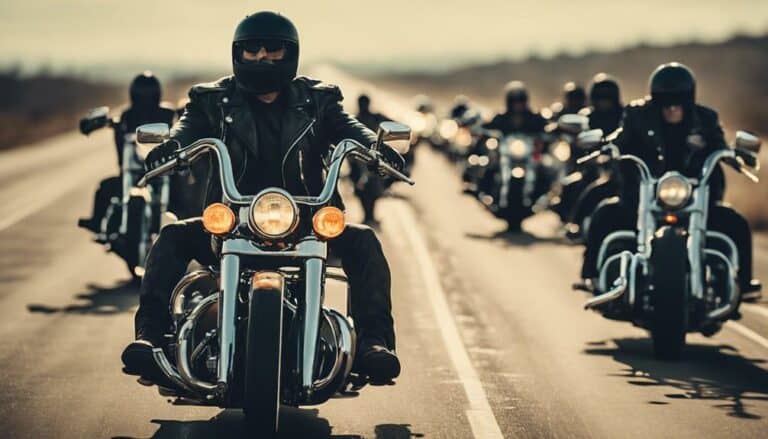Imagine the vast American highways as a tapestry woven with the threads of Harley-Davidson riders, each contributing to a unique chapter in the story of motorcycling culture.
As you ponder the question of how many Harley-Davidson riders roam the U.S. roads, consider the intricate web of factors shaping this iconic brand's presence. From shifting market trends to evolving demographics, the realm of Harley-Davidson ridership unveils a tapestry worth exploring, revealing insights that may surprise even the most seasoned enthusiasts.
Key Takeaways
- Harley-Davidson riders in the US are diverse in age and education level.
- Regional differences in motorcycle culture are evident, with varying rider densities.
- Brand loyalty, quality, and cultural appeal drive Harley-Davidson's popularity.
- Future trends suggest challenges from demographics, competition, and technology for Harley-Davidson.
Harley Davidson Riders in the US: An Overview
In the US, Harley-Davidson riders, comprising approximately 57% college graduates, have an average age of 48 years old. This demographic represents a significant portion of motorcycle enthusiasts in the United States. The appeal of Harley-Davidson motorcycles seems to transcend age barriers, as evidenced by the diverse age range within their rider community. The brand's iconic status and reputation for quality craftsmanship have contributed to its popularity among riders of varying backgrounds.
Furthermore, the statistics on registered motorcycles in different states shed light on the concentration of Harley-Davidson riders across the country. States like Iowa, New Hampshire, and South Dakota show varying levels of motorcycle ownership per capita, indicating the regional differences in motorcycle culture and prevalence. Understanding these regional dynamics can provide valuable insights into the distribution and popularity of Harley-Davidson motorcycles in the US.
Current Statistics on Harley Davidson Riders
Providing insights into the current demographics of Harley-Davidson riders in the United States reveals valuable trends and patterns within this motorcycle enthusiast community. Here are some key statistics:
- Approximately 57% of Harley-Davidson riders in the U.S. are college graduates, indicating a strong educational background within this group.
- The average age of a Harley-Davidson rider in the U.S. is around 48 years old, reflecting a mature and experienced rider base.
- Iowa boasts 18 people for every registered motorcycle, pointing to a significant presence of Harley-Davidson riders in the state.
- New Hampshire follows closely with 17 people for every registered motorcycle, showing a notable Harley-Davidson rider population.
- South Dakota stands out with only 12 people for every registered motorcycle, highlighting a concentrated community of Harley-Davidson riders in the state.
These statistics shed light on the diverse and dedicated community of Harley-Davidson riders across the U.S., showcasing a mix of education levels, age groups, and regional concentrations.
Regional Distribution of Harley Davidson Riders
The regional distribution of Harley Davidson riders in the United States offers insights into the varied concentrations of this motorcycle enthusiast community across different states.
In 2011, Iowa had 18 people for every registered motorcycle, while New Hampshire had 17, showing a higher density of riders. On the other hand, South Dakota had the lowest ratio with only 12 people for every registered motorcycle, indicating a higher prevalence of Harley-Davidson riders in the state.
South Dakota's allure to Harley enthusiasts is further demonstrated by the fact that 77% of surveyed riders at the Sturgis Motorcycle Rally rode a Harley-Davidson, emphasizing the brand's popularity in the region.
These statistics highlight the regional disparities in Harley-Davidson ridership across the U.S., with states like South Dakota standing out for their higher concentration of motorcycle registrations and strong presence of Harley-Davidson riders at iconic events like the Sturgis Motorcycle Rally.
Factors Influencing Harley Davidson Rider Numbers
Factors such as brand loyalty, reputation, and cultural appeal play significant roles in influencing the numbers of Harley-Davidson riders in the US.
- Brand loyalty among Harley-Davidson riders fosters a sense of community and belonging.
- The reputation of Harley-Davidson for producing high-quality motorcycles attracts enthusiasts seeking reliability and performance.
- The cultural appeal of the Harley-Davidson brand, with its rich history and iconic status, resonates strongly with riders.
- The higher percentage of college graduates among Harley-Davidson riders suggests an educated and possibly affluent demographic.
- The average age of 48 for Harley-Davidson riders indicates a mature audience that values tradition and craftsmanship over trends.
These factors collectively contribute to the enduring popularity of Harley-Davidson motorcycles in the US.
The annual Sturgis Motorcycle Rally in South Dakota, drawing hundreds of thousands of riders, serves as a testament to the brand's lasting influence and appeal among motorcycle enthusiasts nationwide.
Future Projections for Harley Davidson Riders
Examining future trends for Harley Davidson riders reveals shifting demographics and potential market challenges. As the average age of Harley-Davidson riders in the US is currently 48 years old, an important factor to consider is how this age demographic will evolve in the coming years. Additionally, with approximately 57% of Harley-Davidson riders in the US being college graduates, there is a correlation between education level and brand preference that could impact future market share.
| Factors | Implications |
|---|---|
| Aging Population | Potential decrease in new Harley-Davidson riders as the current demographic ages. |
| Education Level | Higher percentage of college graduates among riders may indicate a more affluent customer base. |
| Market Competition | Increased competition from other motorcycle brands may challenge Harley-Davidson's market share. |
| Economic Trends | Economic fluctuations could affect motorcycle sales, influencing the number of new riders entering the market. |
| Technological Advancements | Adoption of new technologies in motorcycles could attract or deter potential Harley-Davidson riders. |
Conclusion
As you reflect on the vast number of Harley-Davidson riders in the US, envision a sea of riders, each one embodying the spirit of freedom and adventure that comes with owning a Harley.
With their unwavering loyalty and passion for the brand, these riders continue to shape the landscape of American motorcycling culture.
The future looks bright for Harley-Davidson, with a community united by a shared love for the open road and the iconic rumble of a Harley engine.

